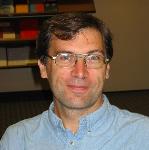


Patrice Koehl
Department of Computer Science
Genome Center
Room 4319, Genome Center, GBSF
451 East Health Sciences Drive
University of California
Davis, CA 95616
Phone: (530) 754 5121
koehl@cs.ucdavis.edu

 |

| Patrice Koehl |
Modeling and Data Analysis in Life Sciences: 2017Lab 6: Population dynamics via cellular automataHandoutsCellular automata:
Word document (click to download) or PDF document (click to download) Cellular automataCellular automata provide a simplified way of modeling physical, biological or social phenomena. In a CA model the "universe" is divided up into small cells. Each cell can take any one of a finite number of states (such as. live or dead). A single generation is determined by assigning a state to each of the cells. Then a strict (and often quite simple) set of rules is used to determine how a given generation evolves into the next one. The model then consists of repeated applications of the rules to obtain each successive generation from the previous one. In principle this iteration can go on forever; in computer implementations however, it goes on for a finite (possibly quite large) number of generations. There is much interest in CA models among mathematicians and applied scientists such as ecologists or biologists. Let us consider a flat square universe, divided up into an \(N \times N\) array of small cells, denoted \((i, j)\), for \(i, j = 1, \ldots, N\). The states of these cells may be represented as the elements \(A(i, j)\) of a matrix \(A\). The immediate neighbors of cell \((i,j)\) are defined to be those cells that touch it (excluding cell \((i,j)\) itself). So an interior cell \((i,j)\) (where \(i = 2,\ldots,n-1\) and \(j = 2,\ldots,n-1\)) has immediate neighbors \((i-1,j-1), (i-1,j), (i-1,j+1), (i,j-1), (i,j+1), (i+1,j-1), (i+1,j)\), and \((i+1,j+1)\): 
In this universe, each cell can occupy only two states (alive or dead, but other interpretations are possible). We represent these by setting \(A(i,j) = 1\) when the cell \((i,j)\) is alive and \(A(i, j) = 0\) when it is dead. Each generation is determined from the previous one according to (majority scheme):
To apply these rules consistently, we need to define the states of the cells that lie just outside the boundary of the universe (remember that our universe is finite, of size \(N \times N\)). For example, we shall say that all cells outside the boundary of our universe are assumed to be dead. The purpose of this project is to generate a model for this simple automaton, i.e. a finite number of generations, starting from a random initial organization of the universe.
|
| Page last modified 15 June 2022 | http://www.cs.ucdavis.edu/~koehl/ |